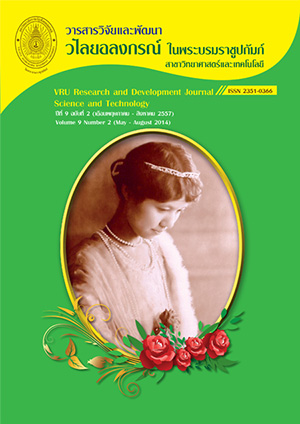อินเวอเตอร์แบบปรับความถี่อัตโนมัติสำหรับงานวัสดุศาสตร์
Main Article Content
บทคัดย่อ
This research has the objective. For study designs and it builds the metal blast furnace model. By use the principle works of Automatic Variable Frequency Inverter for Material Applications. and work use the worker of the model by at want for the heat. Be the size iron as M6, M8, M10. Study the influence of the frequency. The energy carrying forward influence of the translation frequency in for is the heat one inventory with by have testing as follows.
1. The frequency decrement compares with and while it uses in the heat giving.
The one compares with and while it uses in the heat giving. Meet the frequency acting to switch inverter meet the low frequency to use the time in the doing to give the hot work acting. Will use in the decreasing doing for the hot work and because of be the condition of impedance in the decreasing. Make the electric current to be valuable most
2. The electric current pull of the frequency value at use
The electric current pull of the frequency value at use. Meet the condition acting of resonance. It will be the most most heat condition at be appropriate for The heat giving by live the induction. And because be the condition impedance. It is valuable minimumly. Energy can be heat be born and most.
3. The electric current pull of the capacitor is different.
The electric current pull of the capacitor is different. Meet the times value acting The frequency value is same and The capacitor value goes up. Will do the inverter current valuable to decrease low. Thus at the frequency value is same and The inverter current value picks to load differently. The electric current pull of will go out.
Article Details
ลิขสิทธิ์บทความวิจัยที่ได้รับการตีพิมพ์เผยแพร่ในวารสารวิจัยและพัฒนา วไลยอลงกรณ์ ในพระบรมราชูปถัมภ์ ถือเป็นกรรมสิทธิ์ของสถาบันวิจัยและพัฒนา มหาวิทยาลัยราชภัฏวไลยอลงกรณ์ ในพระบรมราชูปถัมภ์ ห้ามนำข้อความทั้งหมดหรือบางส่วนไปพิมพ์ซ้ำ เว้นแต่จะได้รับอนุญาตจากมหาวิทยาลัยเป็นลายลักษณ์อักษร
ความรับผิดชอบ เนื้อหาต้นฉบับที่ปรากฏในวารสารวิจัยและพัฒนา วไลยอลงกรณ์ ในพระบรมราชูปถัมภ์ เป็นความรับผิดชอบของผู้นิพนธ์บทความหรือผู้เขียนเอง ทั้งนี้ไม่รวมความผิดพลาดอันเกิดจากเทคนิคการพิมพ์
References
กระวี จันทรสีมาวรรณ และชัยณรงค์ ศักดิ์ศรี. การให้ความร้อนแบบเหนี่ยวนำ. ปริญญานิพนธ์
วิศวกรรมศาสตร์บัณฑิต ภาควิชาวิศวกรรมไฟฟ้า คณะวิศวกรรมศาสตร์ มหาวิทยาลัยขอนแก่น
โคทม อารียา, ยุทธนา กุลวิทิต และ วิจิตรวรรณ ประกอบสันติสุข. (2530). การออกแบบและสร้าง เครื่องให้ความร้อนแบบเหนี่ยวนำขนาด 2 kW. การประชุมวิชาการทางวิศวกรรมไฟฟ้าครั้งที่ 11
จีระพงศ์ ศรีวิชัย และภาวดี ทิพย์มาก. (2546).เครื่องเชื่อมไฟฟ้ากระแสตรงแบบอินเวอร์เตอร์. ปริญญานิพนธ์วิศวกรรมศาสตรบัณฑิต ภาควิชาวิศวกรรมไฟฟ้า คณะวิศวกรรมศาสตร์ สถาบันเทคโนโลยีปทุมวัน.
สมคิด องค์รัตนประทาน, ประภาษ ไพรสุวรรณา. (2536). การนำหลักการอินเวตเตอร์มาใช้ทางด้านการ
หลอม โดยการเหนี่ยวนำ” การประชุมวิชาการทางวิศวกรรม ไฟฟ้าครั้งที่ 16, หน้า 57-60.
สุรพล เธียรมนตรี, ยุทธนา กุลวิทิต. (2537).เครื่องให้ความร้อน แบบเหนี่ยวนำ สำหรับให้ความร้อนเบื้องต้น
แก่ลวดตัวนำ ประชุมวิชาการทางวิศวกรรมไฟฟ้า ครั้งที่ 17, หน้า 14-18.
สุวัฒน์ ดั่น. (2537). เทคนิคและการออกแบบสวิตชิ่งเพาเวอร์ซัพพลาย. กรุงเทพฯ : บริษัท เอนเทล ไทยจำกัด.
อนุวัฒน์ จางวนิชเลิศ, ยุทธนา กุลวิทิต. (2537). เครื่องให้ ความร้อนแบบเหนี่ยวนำที่ใช้ เอส ซี อาร์ สำหรับ
ลด ความเครียดในแท่งเหล็ก. ประชุมวิชาการทางวิศวกรรมไฟฟ้า ครั้งที่ 17, หน้า 19-24.
Davies and Simpson, P. (1979). Induction Heating Handbook. McGraw-Hill.
Dede,E.J. Esteve, V. Gonzalez, J.V. Garcia, J. Lapiedra L. and Fernadez. M. (1991). Design of
A Series Resonant Converter For Induction Heating. IEEE pp.1384-1387
Fujita, H. Akagi, H. Mita, K. and Leonard, R.H. (1993). Pulse Density Modulation Based Power
Control of 4 kW 400 kHz Voltage-Source Inverter for Induction Heating
Applications” PCC-Yokohama, pp 111- 116.
Ogiwara, H. Nagai, S. Nakaoka, M. and Hamada, S. (1990). The State-of-the Art Advanced
Developments of Series- Resonant High-frequency Inverter Using Static Induction
Transistors/Power Modules.” IEEE pp 2040- 2048.
Mohan, Ned., Undeland, M. Tore and Robbins P. William. (1993). Power Electronics
Converter: Application and design, 2nd ed. New York : John Wiley &Sons.
N.S.Gehlot and P.J.Alsina. (1990). Medium Frequency Dead Beat Controlled PWM Inverter
with Parameter Estimation for Induction Heating. IEEE. pp 209-334.
Frank, W.E. and Der, C.F. (1982). Solid State RF Generators for Induction Heating
Applications. Appl. Soc. Meet; IEEE Ind. pp 285-290.
Zinn and Semiatin, S.L. (1991) .Elements of Induction Heating Design, Control, and
Applications.Electric Power Research Institute, Inc.
http://www.nidambe11.net/ekonomiz/2005q1/article2005jan20p6.html

